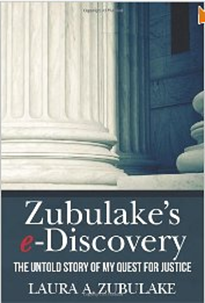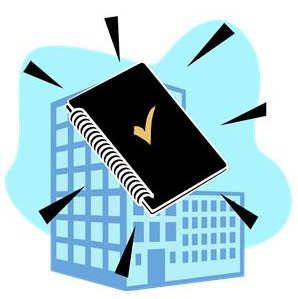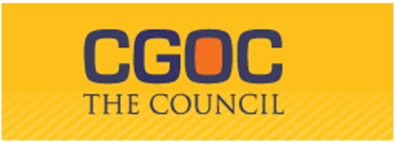eDiscovery Trends: Interview with Laura Zubulake of Zubulake’s e-Discovery

Last week, we discussed the new book by Laura A. Zubulake, the plaintiff in probably most famous eDiscovery case ever (Zubulake vs. UBS Warburg), entitled Zubulake's e-Discovery: The Untold Story of my Quest for Justice. I also conducted an interview with Laura last week to get her perspective on the book, including her reasons for writing the book seven years after the case ended and what she expects readers to learn from her story.
The book is the story of the Zubulake case – which resulted in one of the largest jury awards in the US for a single plaintiff in an employment discrimination case – as told by the author, in her words. As Zubulake notes in the Preface, the book “is written from the plaintiff’s perspective – my perspective. I am a businessperson, not an attorney. The version of events and opinions expressed are portrayed by me from facts and circumstances as I perceived them.” It’s a “classic David versus Goliath story” describing her multi-year struggle against her former employer – a multi-national financial giant. The book is available at Amazon and also at CreateSpace.
Our interview with Laura had so much good information in it, we couldn’t fit it all into a single post. So, today is part 1. Part 2 will be published in the blog tomorrow!
Why did you decide to write the book at this time, seven years after the case was decided?
Actually, I’ve been working on the book for several years and I think it got to the point where I decided either I publish or I don’t publish. It’s been a work-in-progress for some time and took me longer than I would have expected or liked, but it finally came together. I probably started it a couple of years after everything was finalized, so it has taken from that point until now to complete it and get it to the point where it is now that I was happy with the results.
What do you expect that those who are familiar with the Zubulake opinions to get out of the book?
Number one, I think it’s really important to note that it’s from the plaintiff’s perspective. What I find is that most of what you read about in the industry and hear at eDiscovery and legal conferences discuss topics from a defense standpoint. Most are either a consultant to a defendant or an attorney representing a defendant and I find that the plaintiff’s voice is rarely heard. And, I felt that I saw things differently from not only the defendant but also my attorneys from time to time because it was my case, I was taking the risks and I had a lot at stake. So, I think hearing from the plaintiff not just about going through the motions filed and oral arguments and all that but also about life at home and what it’s like dealing with the day-to-day stresses as a plaintiff in a case that lasts three years. I wanted people to appreciate the difficulty of it. I’m sure most people would assume it’s difficult, but I’m not sure how much people understand about the isolation and how going through litigation can be a lonely place. I write about that in the book.
Number two, a lot has been written about the Zubulake opinions. Most of it is accurate, but not all of it. I thought some of the things that were not accurate should be clarified because they were important. Like, for instance, the role that the adverse inference instruction apparently played to the jury. I only learned about its role in the verdict during post trial discussions. Whenever I mention that observation to people, they find that interesting. I think there are events throughout the litigation that people might learn that what they read in the press is not necessarily 100% accurate.
Also, I think that eDiscovery is still an issue for a lot of medium sized corporations (and probably large corporations, as well). I think hearing from someone who went through the process would be valuable to them, especially when you consider that I did so without the aid of legal guidelines because there were very few guidelines at the time as I mentioned and also very little technology available. I had to do it from a very basic standpoint. So, when you learn anything, it’s really good to learn it from the foundation, from the basics. From that, you can apply technology and strategies that have been developed over the years. So, I’m hoping that everybody who reads it will learn something from my experience.
What do you expect that those who are unfamiliar with, or don’t understand the significance of, the Zubulake opinions to get out of the book?
Well, it’s difficult to write a book. When I wrote my first book several years ago about convertible securities, that was what I did for a living and I knew them very well. I lived this case, so, clearly, I knew it very well. The problem you have as a writer is not assuming that the reader knows what you know. So, I tried to write it as clearly as possible and some who are experts in eDiscovery may not find the book to be technical enough, but that was intentional as my goal was to try to appeal to as broad an audience as possible. That’s always difficult, but that was my goal. I hope readers learn about the significance of the opinions, learn about the changes in law, and appreciate the plaintiff's viewpoint.
To the readers, as always, please share any comments you might have or if you’d like to know more about a particular topic!
Disclaimer: The views represented herein are exclusively the views of the author, and do not necessarily represent the views held by CloudNine Discovery. eDiscoveryDaily is made available by CloudNine Discovery solely for educational purposes to provide general information about general eDiscovery principles and not to provide specific legal advice applicable to any particular circumstance. eDiscoveryDaily should not be used as a substitute for competent legal advice from a lawyer you have retained and who has agreed to represent you.









